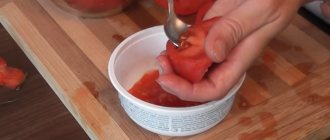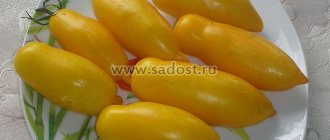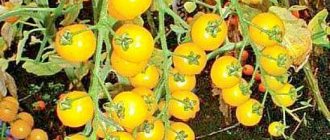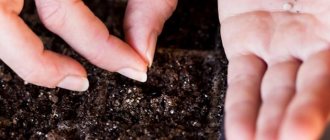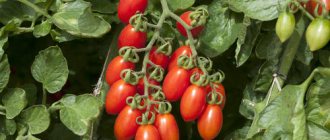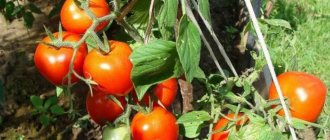Pink Dream is an early ripening tall variety with large fruits, bred agro. In the south it can be grown in open ground, but in the middle zone and in the north it is better to grow it in a greenhouse, despite its precocity. In a cultivation facility, the yield of the variety is much higher.
| Height | Landing location | Ripening time | Fruit color | Fruit size | Origin | Fruit shape |
| Tall | Greenhouse | Early ripening | Pink | Large | Variety | Flat-round |
Description of the variety
The variety is indeterminate and early ripening. It is grown both in the north of the country and in the south. In regions with climatic instability, gardeners plant Pink Dream in greenhouses or greenhouses. The plant is unpretentious to soils, shows high productivity and a long fruiting period.
Distinctive features
The bush reaches a height of about 2 m and requires shaping. The inflorescence is simple, the foliage is medium, dark green. On average, the ripening period is about 80-100 days, depending on the growing region and weather conditions. Pink Dream is a universal variety with a high content of vitamins and microelements.
Characteristics of tomatoes and yield
From 1 sq. m, about 10 kg of beautiful tomatoes are collected. The weight of one is 300-450 g, the shape is spherical, large. The color is pink-red. The surface is smooth, and the stalk is slightly ribbed. The taste is juicy and sweet. The skin is dense, so Pink Dream is stored for a long time without losing its external and taste properties.
Properties and Features of Tomato Cetus
Among other varieties, the “Cetus” pink tomato stands out for its unusual color and improved characteristics.
When choosing seeds for planting, pay attention to this vegetable and learn more about it
Features of the variety
This is a hybrid variety bred in Spain and is well suited for cultivation in various regions of Russia. It combines all the qualities necessary for tomatoes. It has an interesting taste and contains more vitamins than red tomatoes.
When breeding the variety, the emphasis was on combining high taste qualities and growing efficiency. The result was the following characteristics:
- Fruit quality. They are dense and have a rounded-flat shape. The color is rich, with a crimson tint on top, pink in the cut.
- High yield potential. Tomatoes are early ripening, resistant to cladosporiosis, fusarium, verticillium and other major diseases, and easily tolerate heat and drought. The plant is well balanced. The fruits are collected in clusters of 6-8 pieces. The flowers are characterized by high viability, which ensures a good percentage of set and allows you to get up to 5 full-fledged tomatoes from the first bunch.
- Easy to care for. The bushes grow up to 2 m high, but are quite compact. Their leaves are sparsely spaced and the internodes are short. This reduces labor costs during the growing season.
- Good transportability. The strong skin and dense wall protect against damage during transportation. The fruits are resistant to cracking and are stored for a long time.
The root system of tomatoes is well developed. The plant turns out strong and has high growth energy, which allows you to get a yield that is 20% higher than the standard one.
How to grow
Tomatoes of this variety are classified as indeterminate. This means that they can be grown all year round in film and glass greenhouses of any height. Vegetables are propagated by seeds. After planting, the seedlings begin to bear fruit in 60-65 days.
The plant is unpretentious to agricultural technology, but compliance with growing rules ensures an increase in yield with a long rotation with planting in March-April and harvesting in September up to 25 kg/m². A short rotation allows you to quickly get 4-6 bunches, but the fruits will be smaller, and you won’t get more than 15 kg of tomatoes per 1 m².
The average fruit weight is 250-270 g, but by rationing the bunch and removing part of the ovary, you can get tomatoes up to 300 g. When planting, you need to maintain a distance between plants, fertilize and moisten the soil, and tie the stems to a support. This will preserve and increase the harvest.
The fruits of these tomatoes are beautiful and tasty. Their value increases due to early ripening and the content of useful substances.
How to grow seedlings
Preparing seedlings is simple; the main thing is to know the basic rules for growing them. As a rule, it is recommended to sow seeds 50-60 days before planting plants in the ground. To do this, select the appropriate seed, container and soil.
Seed preparation
When purchasing seeds, pay attention to the reputation of the manufacturer, and not to the bright and beautiful packaging. Study customer reviews or recommendations from neighboring gardeners and only then choose the right supplier. We do not recommend buying material in unverified places; it is best to contact specialized stores.
After purchasing, the seeds must be disinfected. This is done using aloe juice, hydrogen peroxide or a solution of potassium permanganate. Soak the seeds in one of the solutions for 24 hours, then place them on a cloth and dry well. Disinfection is a mandatory stage of seed preparation; it destroys dangerous microorganisms on the surface of planting material.
The next stage is hardening. Place the seeds in the freezer overnight and then leave them in the room for 10 hours. Repeat the algorithm several times and be sure that the plant will not be afraid of cold weather in the future.
After hardening, many gardeners germinate the seeds - place them in a damp cotton pad and leave in a dark place for 5-7 days. It is believed that with the help of germination, the general germination of seeds is checked and their immunity is strengthened.
Container and soil
Good soil should be loose and nutritious and meet the required acidity level.
In addition, the soil must be well permeable to water and moisture. The composition of humus and chernozem in a ratio of 2:1 is recognized as an excellent mixture. For drainage, add 1 part of river sand or sawdust to such soil.
Any containers can be used: plastic cassettes, peat pots, plastic disposable cups, and so on.
Wash the container well and dry it, then treat it with hydrogen peroxide.
Sowing
Before sowing, make a drainage layer at the bottom of the container. This simple operation protects seedlings from root rot and blackleg. After drainage, pour the prepared soil into the container and water with warm water. Cover the container with film or thin glass and leave for 5-6 hours.
Then use a pencil or toothpick to make small holes in which to place the seeds. Sprinkle the grooves with soil, pressing down lightly. Use a spray bottle to moisten the grooves and cover the seedlings with film.
Important! If you are planting several tomato varieties at once, we recommend making markings. On a piece of paper, write down the date of planting and the name of the variety. This will help you not to get confused in the names of tomatoes and not to miss the date of planting in the ground.
Growing and care
The seedlings are kept in a warm and bright place. The first week the air temperature should be at least 23 degrees. As soon as the sprouts have sprouted, the film is removed. Water the seedlings with warm filtered water as the soil dries. It is important to avoid excess moisture, as this leads to the risk of fungal infection.
After 7-10 days, the air temperature is reduced to 19 degrees Celsius. Regular ventilation is also necessary. After 2 weeks of planting seedlings in the ground, the container is taken out to the balcony for 1-2 hours, subsequently increasing the time. This way the seedlings are hardened off.
Seedlings must be fed. Ideally, combine mineral and organic fertilizers. Among organics, nettle solution or ash are considered an excellent remedy; among mineral complexes, it is recommended to use “Fitosporin+” or “Baikal”.
Features of cultivation
Seedlings of the variety are usually sown in March. It is recommended to plant the seeds under the film in loose soil to a depth of 1 cm. The film is removed after the first shoots (after about 5-7 days). And after 20-30 days you can pick. You should plant a tomato in the ground after making sure that frosts are not expected and the weather will be consistently warm.
How to grow tomatoes
When growing Pink Dream, pay special attention to bush formation and watering. Let's look at what advice experienced gardeners give to beginners.
Landing
It is best to plant tomatoes in clean and fertile beds. Since the fall, it has been advised to dig up the ground and burn weeds and debris. With the arrival of spring, the garden is dug up a second time and disinfected with a manganese solution. It would be a good idea to place a layer of straw between the rows. It nourishes the soil and retains moisture.
For 1 sq. m place no more than 4 Pink Dream bushes. Since the bush is indeterminate, place a wooden stake for a garter near each one. Replant the seedlings carefully, try not to break the still weak and fragile stems. After planting, water the beds thoroughly.
Important! It is best to plant tomatoes in the morning or evening on a windless, cool and cloudy day.
Care
For the first time, tomatoes are watered at the root 5-8 days after planting. Subsequently, the soil is moistened once a week. On average, one Pink Dream bush requires about 1.5 liters of water. Bushes especially need moisture during flowering and fruiting. However, remember that excess moisture leads to cracking of tomatoes.
Important! Rainwater is ideal for irrigation. It contains microelements necessary for the plant.
Another important stage of crop care is the application of organic and mineral fertilizers. Tomatoes especially love nitrogen-containing substances. Pink Dream perfectly accepts ammonium nitrate and nitrophoska. The preparations nourish the bush, accelerate its development and strengthen the root system. It is recommended to apply nitrogen-containing fertilizers 3 times during the ripening period.
Tomato beds are also fertilized with iodine-based root fertilizers. It protects the variety from late blight and rot. There are 4 drops of iodine per 10 liters of water. Water the bushes with the solution every week, and spray them once every 2 weeks.
Features of cultivation and possible difficulties
Inexperienced gardeners are faced with the problem of forming a bush. The pink dream is formed into one stem, after which the top is necessarily pinched. When forming, all side stepsons are removed, leaving 2 side brushes. Stepchildren are advised to remove them in the morning before they break off easily. In addition to the shoots, yellow and dry leaves are also picked off.
More attention is paid to the stepsons until the tomatoes are set. During this period, the plants are watered with nettle infusion and fed with bird droppings and ash. At the beginning of August, it is advised to completely remove the top of the bush so that the vegetables receive sunlight.
Diseases and pests
Like any living organism, tomato bushes can get sick. Most often, plants are susceptible to the following diseases:
- The fungal infection late blight appears due to excess moisture and improper care. A solution of Bordeaux mixture helps prevent the appearance of brown spots.
- Septoria blight appears as dry leaves and yellow spots. As a preventative measure, use ash or spray with soapy water.
- Tobacco mosaic appears as a yellow spotted pattern on the leaves. Because of the mosaic, the plant stops growing, the tomatoes stop ripening and gaining color. The virus is treated with copper sulfate.
- Powdery mildew is a white coating on the leaves, due to which metabolism is disrupted and the plant does not receive nutrition for development. A yeast solution helps get rid of powdery mildew.
In addition to diseases, the Pink Dream can be attacked by insect pests:
- The Colorado potato beetle is especially common if there are potato beds nearby. Professional preparations “Typhoon Plus” or “Killer” help to get rid of it.
- The mole cricket destroys the roots of the plant, which blocks access to oxygen and soil. Within a short time the bushes wither. The remedy “Medvetox” helps to get rid of mole crickets.
- Aphids are small white flying bugs. Sometimes they cannot be seen with the naked eye, since the insects are mainly hidden on the back side of the leaf. As a preventive measure, use spraying with a solution of potassium permanganate.
Planting seedlings in the soil
If natural light is insufficient, additional lighting is provided with fluorescent lamps to stimulate photosynthesis. It is impossible to carry out illumination throughout the day without interruption, since necessary biological processes also occur in the dark.
At this time, watering the tomatoes is carried out using a watering can, settled with heated water. After the first true leaves appear, the seedlings are planted and the first fertilizing is carried out with mineral complex fertilizers.
2 weeks before planting seedlings in the ground, they are hardened off. To do this, pots with tomato seedlings are taken out into the open air.
Transplanting into a greenhouse begins in early May, and replanting them under film takes place a little later. It is necessary to ensure that the soil at the time of planting has a temperature of at least 14 degrees at a 15-centimeter depth. Seedlings are planted in areas where onions, parsley, zucchini, carrots, and cucumbers previously grew.
Experienced gardeners advise adding wood ash and superphosphate (1 tbsp) to each hole. Tomatoes of this variety are planted in the ground so that their number per 1 sq. m did not exceed 4 plants.
Although the bushes of the variety are not tall, they have quite a lot of stems, so pinching is required. The stepsons break off when their size reaches approximately 4 cm. Usually for 1 tomato bush it is enough to leave 1 - 2 main stems, the rest must be removed in a timely manner.
READ MORE: Description of the Lima bean variety, features of cultivation and care
The nuances of growing in open ground and greenhouses
When growing Pink Dream in open ground, it is recommended to use a drip irrigation system. Firstly, less water is wasted this way; secondly, moisture gets directly under the root, bypassing the leaves and stem, so the risk of diseases is reduced. Plus, using a drip irrigation system it is convenient to apply root fertilizers.
In greenhouse or greenhouse conditions, special attention is paid to temperature conditions. The optimal air temperature should be at least 22 degrees. Also regularly ventilate the greenhouse, as such structures are characterized by high humidity. Ventilate it using special windows or doors.
Disease Prevention
For the purpose of preventive protection of dangerous diseases, it is recommended to use a solution of soda (250 g per 9 liters of water) or an infusion of fresh garlic, which should be infused for two days (300 g of pressed garlic per 7 - 8 liters of water). Treatment can be carried out no earlier than two weeks after planting the bushes themselves. As a replacement, you can use an infusion of celandine, for which you take 1.5 kg of chopped fresh grass per ten liters of water. The mixture should sit for two days.
Among the proven recommendations of experienced gardeners, it is worth highlighting the kefir solution. Before preparing it, the kefir itself must ferment for two days. The solution is prepared in a ratio of 1 to 10. When the stem is sufficiently strong, a neat puncture can be made in its lower part with copper wire, while lowering the ends into the ground. The metal itself must initially be calcined and treated with sandpaper. Wrapping the stems with wire is not allowed. This method can stimulate the respiratory properties of the plants themselves, as well as normalize the level of chlorophyll, which in turn increases the resistance of tomatoes to possible damage from various viral and fungal infections.
Harvesting and application
The ripening period of the variety is extended, so ripe and tasty tomatoes are enjoyed for a long time.
Vegetables can ripen on their own in room conditions. The main thing is to pick the tomatoes together with the stalk, this way they will be stored longer. A basement or cellar is ideal for ripening crops.
Due to their high content of vitamins and minerals, tomatoes are actively used in the preparation of dietary dishes.
Vegetables go well with fish and meat dishes and are considered an excellent snack. In addition, soups, side dishes and salads are prepared from tomatoes.
Interesting! They even make jam from tomatoes. However, this is not a delicacy that is familiar to us, but a special sauce for meat or poultry.
Advantages and disadvantages of the variety
Gardeners consider the advantages of Pink Dream to be high taste and versatility in use. Tomatoes also have an attractive appearance, are stored for a long time and contain a large supply of vitamins. Vegetables ripen quickly and are suitable for growing in any climatic conditions.
The disadvantages include the obligatory formation of a bush and difficulties with canning due to its large size. Otherwise, gardeners like the Pink Dream.
Important nuances
When choosing a variety for further cultivation and use, you should consider that:
- the collected fruits are not suitable for long-term storage and are quite painful to transport, which makes the process of growing tomatoes for further sale almost impossible;
- the bushes themselves are very vulnerable to possible damage by late blight;
- Ripe tomatoes have a thin skin that cracks easily when exposed to high temperatures and excess moisture.
Based on the existing characteristics, the Pink Dream tomato variety is optimally suited for growing in personal plots for further use for one’s own food purposes.
Farmer reviews
Let's look at what exactly they say about the variety.
Nina, Ryazan: “Pink Dream is one of my favorite varieties. The tomatoes ripen quickly and smoothly, and the yield is excellent. 4-6 large tomatoes are tied to the brush at once. I use it mainly fresh, the taste is juicy and bright.”
Alexander, Moscow: “Indeterminate varieties, in my opinion, are the most productive. I collected the first vegetables after 83 days and planted them in seedlings. The only fertilizers I used were nitrophoska and manure.”
Zina, rep. Tatarstan: “I planted the Pink Dream variety for the first time. I planted them in the beds after potatoes, which is probably why the tomatoes developed root rot. It was only possible to get rid of it by the end of July. Because of this, the harvest was meager.”

